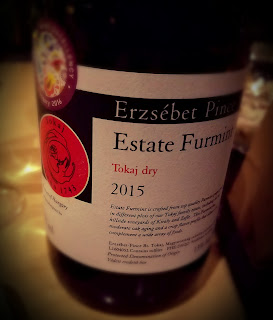A partnership between Black Angus restaurants and
DAOU Vineyards is being celebrated by both parties. A wine pairing dinner was held recently at the chain's Lakewood, CA restaurant. The wines were paired with special dishes prepared by executive Chef
David Boloson, with personality and background provided by
Georges Daou. The dinner showcased the new design of Black Angus, which is set to roll out in 2019, while pairing seasonal favorites with DAOU wines that are now on the restaurant's list.
Black Angus is going with a rodeo nouveau decor, with arty old-west touches - black-and-white photos of cow skulls, rope and saddles are framed in brown wood with silver spur flourishes. It's fancy without being intimidating.
The evening started with a white wine opener, DAOU's
Chemin de Fleur, a blend of Viognier, Grenache Blanc and Roussanne. It is floral and savory at once, with great notes from all three grapes showing nicely amid an old-California dose of oak treatment.
The wine carried me nicely through one of those mingling sessions where I knew not a soul. As usual, I gravitated to a freelancer - this one a USA Today contributor - who could not stop name dropping. Spago, the Polo Club, the Four Seasons, ugh, she was "so over it all." She said Ryan Gosling wanted her to come to a party that night, and I have no idea why she ended up in Lakewood instead.
Georges Daou and his brother
Daniel are from Lebanon, having come of age with bombs bursting outside the kitchen window. They would escape to their grandfather's farm and play among the olive trees. They later escaped to the rest of the world, traveling the globe for education and careers. Their stint in medical technology rewarded them richly and allowed them to retire while still in their thirties. Then, they happened upon Paso Robles while searching for a place to grow and make wine. The Daou brothers' 220 acres in the Adelaide AVA were more than Georges ever dreamed of having.
The Wines
DAOU Chardonnay 2017 - Oaky tropical fruit on the nose, buttery mango, pineapple and citrus flavors, with a great acidity. Paired wonderfully with the crab cake and lemon aioli.
DAOU Cabernet Sauvignon 2017 - Aged ten months in half French oak. Lovely aromas - perfumed, blue and blackberry with Paso earth. The palate offers dark fruit with an earthy overlay, fabulous acidity and very firm tannins. It paired perfectly with lamb in a blueberry cab reduction with roasted veggies.
DAOU Reserve Cabernet Sauvignon 2016 - Aged 20 months half new French oak, dry farmed in limestone-based soil. Earthy, minty dark fruit on the nose shades a hint of anise. Very earthy blackberry and cassis on the palate, with excellent acidity and firm tannins. It paired with the beef Wellington, black truffle demiglace, lobster mashed potatoes and grilled asparagus.
Pessimist Red Blend 2017 - A Rhône blend with zinfandel, it was served with panna cotta, blackberries in choc truffle sauce. It scored in that setting, with a floral perfume on the mocha-tinged nose and flavors of dark fruit, licorice and cassis.
Follow Randy Fuller on Twitter




















